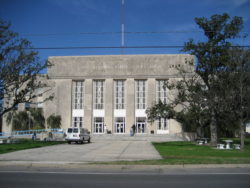St. Bernard Parish Courthouse
The St. Bernard courthouse was constructed in 1939 when the parish seat was transferred from St. Bernard to Chalmette.

Courtesy of Wikimedia Commons
St. Bernard Parish Courthouse. Infrogmation
This courthouse, funded by the Public Works Administration (PWA), was constructed when the St. Bernard Parish seat was transferred from the St. Bernard community to Chalmette. It replaced the 1915 courthouse designed by Toledano and Wogan (now known as the Historic Beauregard Courthouse). Completed in 1939, the St. Bernard Parish Courthouse is an austere modern structure with a central section four stories in height and wider than the slightly recessed three-story wings. With its smooth limestone and spare ornamentation, the reinforced concrete structure projects an image of weight and serious purpose—characteristics of designs by the architecture firm of Weiss, Dreyfous, and Seiferth. Massive fluted pilasters between the five entrance doors and narrow foliated bands define the structure’s architectural elements and enhance the building’s linearity.
Occupying the full width of the interior central section is a two-story lobby with curved staircases at each end; they lead to a balcony, a geometrically patterned terrazzo floor, and walls sheathed in gray-veined marble. The principal courtroom has wood paneling and narrow vertical windows with metal mullions on the exterior that are alternately decorated with magnolia flowers and stylized female representations of Justice.
After widespread flooding from Hurricane Katrina, the courthouse held about four feet of floodwater for several days. The roof was damaged by the hurricane’s winds as well as by flying debris, and rainfall through the roof and broken windows caused further interior damage. Once the water receded, it left behind a thick coating of sludge. The building was cleaned, preliminary repairs were made, and courthouse employees returned to work about a month after the hurricane. During a major renovation project in 2010, however, toxic mold was discovered to have infiltrated the entire building. Renovations were complicated: increased attention to detail had to be paid to preserving this historically significant building and asbestos had to be removed. As renovations proceeded, the courthouse was damaged again by Hurricane Isaac in September 2012, which brought yet another round of delays. The building finally reopened in March 2013.
Adapted from Karen Kingsley’s Buildings of Louisiana, part of the Buildings of the United States series commissioned by the Society of Architectural Historians (www.sah.org) and published by Oxford University Press.
